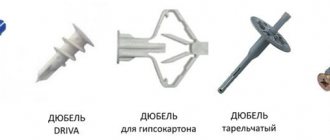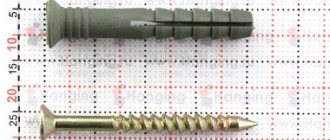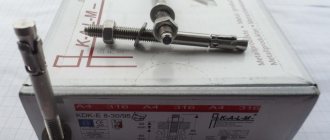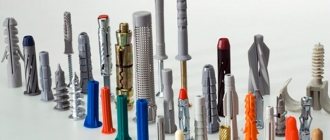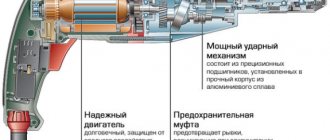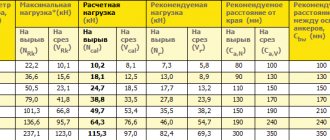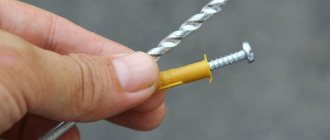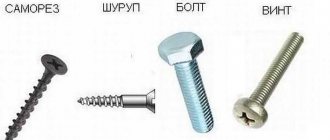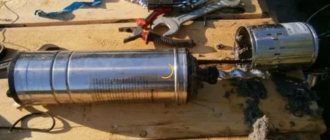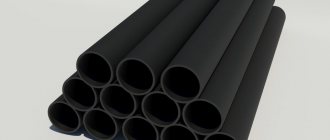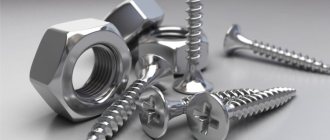Fasteners for concrete walls
When determining which dowel is best for concrete, it is necessary to consider fasteners only for this material, since they differ in certain features. Thus, a brick dowel is not suitable for fastening into a concrete monolith and vice versa. The surface structure is also important - the porosity of the monolith and the presence of cavities in it must be taken into account.
The dowel-nail for concrete and brick is distinguished by a sleeve - classic smooth fasteners can simply be driven (hammered) into the monolith, efficiently and quickly, without the use of special techniques and the expenditure of time, effort, and finances. In brick or aerated concrete, for example, a sleeve without spacer elements will simply destroy the mounting hole due to the presence of cavities and looseness of the material.
The dowel marking always includes a description of the type of material for which the fastener is suitable: for concrete you need to select the appropriate elements and nothing else.
Classic dowels for concrete surfaces
Naturally, dowel fastening of various objects on concrete must be of high quality. The classic option is a plastic bushing with notches along the length and so-called “whiskers” used to prevent the fastener from turning through the hole. The main element of such fastening is a special rod, which contributes to the strength of the fastening in the wall, because when it is used, the bushing in the mounting hole expands. The classic mount is also quite easy to remove. The notches on the rod make it easier to unscrew with a screwdriver.
Composition of concrete and its properties
If you intend to anchor the structure in concrete, it is important to understand what material you will be dealing with. Concrete can be of different quality, composition, and strength. This affects the loads that the surface can withstand.
Concrete is a building material based on cement, sand, crushed stone and water. After installation, the solution hardens, becoming a strong and reliable base. Concrete may contain more than just the components described above. In order to change the properties of the material, various binder components are added to the composition. For example, Portland cement, fly ash, slag and others.
The amount of water - up to 16% of the total volume of the mixture - hydrates the cement. When diluting the concentration, experts recommend using purified water. There are cases in production when water from non-potable sources reduced the strength of concrete.
The following types of chemical impurities may be found in concrete:
- air-entraining agents are used to stabilize air: a good option for improving the thawing of concrete after freezing, thereby increasing the service life of concrete;
- water reducers reduce the amount of added water, which also improves the quality of building materials;
- Set retarders help slow down the hydration process. This is convenient in cases where the finished concrete mixture needs to be transported.
Accordingly, in the process of preparing a concrete mixture, you can use components that improve its properties. It is also possible that errors can occur, due to which the material becomes porous and less durable. When creating a concrete anchorage, it is important to ensure that it will withstand the intended loads.
Features of fastenings for concrete
When choosing fasteners for concrete structures, you should take into account the possibility of eventually removing the dowel and moving the desired object to another place.
Installing dowels in brick walls differs from working with concrete. Reinforced concrete structures allow the use of nails in the form of rods. For brick, studs, screws or similar tabs are more often used. It is important to consider the length of the fastener, as long lengths make installation difficult. Concrete fasteners are used in a variety of applications and are difficult to find replacements for. Dowels allow you to fix household appliances and interior items: hoods, wall cabinets and shelves.
Distinctive features
Dowels for concrete have many differences from brick ones. It is necessary to familiarize yourself with them, because a responsible attitude to work and analysis of information about dowels will affect the outcome of the installation. It is advisable not to use dowels for hard materials on brick surfaces. For such masonry, there are fasteners with certain features and differences from concrete. The dimensions of the sleeve in this case are elongated; it consists of a double spacer - to increase the reliability of fastening, because at least one spacer is guaranteed to hit a hard surface and be fixed on it.
Concrete structures require a nail as a rod; brick structures use a pin, self-tapping screw or other components of dowel fasteners. The length of the rod is of great importance. A fastener that is too long can cause installation difficulties.
A nail used for concrete structures works differently. The principle involves driving a nail into the hole, and this is the simplest way to work with concrete and saves a lot of time. If you use this technique with brick structures or structures made of other loose materials, the surface will simply collapse, and this method will not give the desired effect.
Return to contents
Typical sizes
Let us present the main characteristics of universal products in the form of a table:
| Type | Dimensions | Installation | Permissible load (brick, concrete) | ||||||
| d | L | t | d0 | h1 | Nbet. | Vbet. | Nbrick. | Vbrick. | |
| Expandet Nail Anchor | Ext. anchor diameter, mm | Anchor length, mm | Max. thickness of fixing item, mm | Diameter dia. holes, mm | Min. height depth holes, mm | Tensile load, kg | Cross-river load, kg | Tensile load, kg | Cross-river load, kg |
| 5×30 | 5 | 30 | 5 | 5 | 40 | 30,59 | 35,69 | 20,39 | 35,69 |
| 5×40 | 5 | 40 | 15 | 5 | 50 | 30,59 | 35,69 | 20,39 | 35,69 |
| 5×50 | 5 | 50 | 25 | 5 | 60 | 30,59 | 35,69 | 20,39 | 35,69 |
| 6×35 | 6 | 35 | 5 | 6 | 45 | 45,88 | 56,08 | 30,59 | 56,08 |
| 6×40 | 6 | 40 | 10 | 6 | 50 | 45,88 | 56,08 | 30,59 | 56,08 |
| 6×50 | 6 | 50 | 20 | 6 | 60 | 45,88 | 56,08 | 30,59 | 56,08 |
| 6×60 | 6 | 60 | 30 | 6 | 70 | 45,88 | 56,08 | 30,59 | 56,08 |
| 6×70 | 6 | 70 | 40 | 6 | 80 | 45,88 | 35,69 | 30,59 | 35,69 |
| 8×50 | 8 | 50 | 10 | 8 | 60 | 56,08 | 91,77 | 45,88 | 91,77 |
| 8×60 | 8 | 60 | 20 | 8 | 70 | 56,08 | 91,77 | 45,88 | 91,77 |
| 8×80 | 8 | 80 | 40 | 8 | 90 | 56,08 | 91,77 | 45,88 | 91,77 |
| 8×100 | 8 | 100 | 60 | 8 | 110 | 56,08 | 50,98 | 45,88 | 50,98 |
| 8×120 | 8 | 120 | 80 | 8 | 130 | 56,08 | 50,98 | 45,88 | 50,98 |
| 8×140 | 8 | 140 | 100 | 8 | 150 | 56,08 | 50,98 | 45,88 | 50,98 |
| 10×80 | 10 | 80 | 30 | 10 | 90 | 76,47 | 50,98 | 56,08 | 50,98 |
| 10×100 | 10 | 100 | 50 | 10 | 110 | 76,47 | 50,98 | 56,08 | 50,98 |
| 10×120 | 10 | 120 | 70 | 10 | 130 | 76,47 | 50,98 | 56,08 | 50,98 |
| 10×140 | 10 | 140 | 90 | 10 | 150 | 76,47 | 50,98 | 56,08 | 50,98 |
| 10×160 | 10 | 160 | 110 | 10 | 170 | 76,47 | 50,98 | 56,08 | 50,98 |
Table 1.
Here the lateral load is the weight that the dowel can support. This is a force directed vertically. That is, from the center of the edge of the fastener to the ground.
Material for making fasteners
A dowel for concrete can be made of metal or plastic. Metal guarantees strength and rigidity and has greater load-bearing capacity. Plastic fasteners are not subject to corrosion, have greater elasticity and viscosity, therefore they are easily deformed and even under such influences the fastener is not destroyed.
All plastic pins will burn even after the flame source is removed. Therefore, this type of fastener is not used in fire hazardous facilities.
Plastic dowels for concrete:
- Polyethylene - resistant to acids, lightweight, provide excellent viscosity, are not afraid of deformation, and act as a dielectric. Over time, the material may age and crack. Cold-resistant – fasteners can be used in temperatures down to -40 C.
- Polypropylene - less resistant to cold, but provides greater wear resistance and hardness. The material is resistant to heat - it deforms only at temperatures above +140 C. It can also crack.
- Polyamide (nylon) dowels for concrete are strong, rigid, viscous, resistant to vibration, are not afraid of mechanical damage, and have good wear resistance. Such dowels are considered the most reliable and durable, but have one drawback - they are hygroscopic, and therefore exclude the possibility of installation in frost and high humidity.
Metal dowels for concrete are not much different in structure and shape from plastic fasteners, but are presented in a smaller range. The metal is rigid and durable, but it has less viscosity and elasticity, so it loses its properties when deformed.
Metal dowel-nails for concrete:
- Galvanized and stainless steel are not afraid of corrosion and provide a reliable, rigid connection.
- Special alloys with chromium, titanium, bronze, brass are durable, particularly resistant to corrosion, and are expensive, so they are relevant only for certain cases, particularly important fasteners.
Features of application
The installation process is carried out in several stages. The main ones:
- Preparing the hole.
- Train room.
- Installation of the anchor in the uncured polymer mass.
- Tightening the nut.
Each of these stages is associated with its own characteristics.
For installation you will need:
- chemical anchor;
- injection gun;
- stud or threaded fittings;
- hammer drill or drill;
- Boer;
- torque wrench;
- metal brush;
- manual or industrial vacuum cleaner;
- Remedies.
Once you have the tools, you can begin installing the chemical anchor.
Preparing the hole
When working with brickwork, it is important to avoid splits and cracks in the brick. This requires refraining from using the hammer function on the equipment and drilling perpendicular to the plane
To successfully install a chemical anchor for hollow bricks, a hole that is 2 millimeters larger than the diameter of the stud is required. It is necessary to apply a mark on the drill in advance corresponding to the length of the anchor, or use a depth limiter.
To improve adhesion, you need to thoroughly clean the hole from dust and crumbs. This is done using a metal brush and a hand pump, with which the hole is blown several times until there are no visible dust residues.
Introducing the composition
The polymer mass is injected into the hole using an injection gun. If the mixture has a uniform gray color, then it can be used. It often happens that initially it is not possible to achieve high-quality mixing - such a mixture should not be used. To use the gun, you need to place the nozzle in the drilled cavity and fill it with the composition. After each dose of glue placed in the hole, you need to remove the tool a little until more than 65% of the cavity volume is filled.
The procedure for placing a chemical dowel into a hollow brick is characterized by a number of features. They are due to the fact that the presence of a large number of voids does not allow the formation of a natural hole. To achieve the goal, a special plastic sleeve is inserted and filled with glue. When a pin is immersed in a hollow brick, part of the chemical composition escapes through the mesh walls of the sleeve into the cavity. This promotes greater grip.
There are also special ampoules. They are placed in the hole, the composition is mixed using a pin. The second option is more suitable for piece work, when there is no need to buy cartridges with a chemical composition.
Installing a metal anchor
We place the metal structure in the hole using rotational movements
It is important to distribute the solution evenly. To do this, it is recommended to periodically pull the fastener towards you and only then tighten it.
While the glue dries, you can correct the position of the anchor.
Tighten the nut
After waiting for the polymer mass to completely harden, you can proceed to installing equipment and structures. The manufacturer's instructions indicate the maximum force applied to tighten the nut. It is recommended to use a torque wrench to control the applied forces.
Chemical anchors are suitable for fasteners made of steel. Due to its positive properties, the anchor can be installed in high humidity or even under water. When used correctly, it is possible to avoid destruction of the brick, which allows installation at the very edge of the surface.
Chemical anchor is a new direction in construction, thanks to which complex work is simplified. The supply market is becoming more extensive, a larger number of anchors with various new fastener characteristics are appearing.
Material for making fasteners
Materials for the manufacture of dowels for concrete can be: plastic; metal. According to the installation method, fasteners can be: driven in with a hammer; install using a construction gun.
Plastic dowel in concrete
The fastener contains a cylindrical rod that expands when a nail is driven into its cavity, which ensures a strong fastening.
- At the upper end there is a cuff that prevents the fasteners from sinking into the pre-drilled hole. The cuff can be cylindrical or hidden.
- There are products with “whisker” spacers to increase the strength of fixation of fasteners in concrete.
- The dowel-nail can have a thread on the surface and a slot on the head. Screwdrivers are used to install such an element. The most common materials used for manufacturing are polyamide, polypropylene or polyethylene. The nail itself uses galvanized steel alloy.
- Plastic fasteners - their price is lower and are used for mounting small items. For heavy structures, their metal analogues are used.
Metal dowel for concrete
This type of fastener has a metal rod with a smooth surface without threads. The part expands when a nail is driven into a hole in the wall.
Tip: It should be borne in mind that metal dowel-nails are quite difficult to dismantle, so they are installed for a long period of use.
Doweled nails are installed when installing suspended ceilings and various metal frames. The greatest strength of fastening can be achieved on solid and hard materials.
Application area
Wall shelves are attached to the wall using dowels.
The use of this type of fastener is advisable in various fields. It is an important part that is difficult to find a replacement for. When renovating an apartment, many household appliances and interior items - hoods, wall cabinets, kitchen furniture - must be hung and mounted on the wall. They are held in place thanks to the use of dowels - reliable mounting elements.
Return to contents
What is a dowel-nail
A dowel-nail is a metal fastener that is hammered or screwed into a plastic or metal body. The installation process looks like this:
- A hole is drilled in the material.
- Insert a bushing into the hole.
- They hammer a nail inside.
The expansion mechanism expands and the fastener gets stuck in the concrete or brick. This results in a reliable connection. It does not lose its properties for several years.
The service life depends on the type of materials from which the elements are made and on external conditions. High humidity will cause even a galvanized rod to oxidize, and direct rays of the sun will destroy the plastic sleeve.
If the length of the nail does not exceed 50 mm, then its maximum curvature will be 0.1 mm.
We invite you to watch a video about the types and characteristics of dowels:
Installation features
To drive a dowel into a concrete wall, it is not necessary to invite craftsmen. You can do everything yourself. You will need the following tools and materials: the dowel itself of a certain design, a sharp nail, an electric drill and a Pobedit drill (you can use a hammer drill), electrical tape, a small hammer.
The main stages of fastening:
- The installation location is planned after careful design.
- Using a hacksaw, nail or anything else, make a small indentation in the marked area.
- A drill bit for an electric drill of the appropriate diameter is selected - it must exactly match the size of the screw and the required hole for it. The dowels must be inserted into the hole with force in order to securely fasten inside. It is advisable to make a mark on the drill with a piece of electrical tape along the depth of the hole with a small margin to limit drilling. The drill must be strictly perpendicular to the surface. A hole is made.
- You need to remove dust, debris, crumbs from the hole - it is better to do this with a vacuum cleaner, but you can use anything.
- Next, a plastic or metal dowel for concrete is carefully installed into the hole, driven with a hammer to the maximum stop with strong, precise movements, and a screw is screwed into it (if screws are supposed to be included in the construction kit).
How to install a dowel in concrete?
Installing dowels in a concrete base can be done even by beginners who are encountering such work for the first time. You don’t have to turn to specialists for help to secure furniture, grilles, or heavy structures. To create the fastening you will need a drill with a drill, electrical tape and a hammer (preferably with a rubber working part).
Step-by-step instructions and recommendations for installing dowels in concrete:
- Mark the locations of the dowels on the concrete surface. At this point you need to make marks and a small indentation along which you will drill later.
- Select a drill bit for the pilot hole. To create the hole you will need an electric drill. It would be better if it has adjustable speed.
- If you have made the correct hole, the dowel will go in gradually and with great ease.
- Use electrical tape on the drill to mark a limit line that must be adhered to when drilling.
- Hold the drill perpendicular without changing the angle so that the hole is even and the fastening is secure.
- Construction materials, debris, and dust must be removed from the created hole.
- After this, you need to install concrete dowels. Hammer it with a rubber hammer until it stops.
- Screw a screw of the required size for a specific dowel. For convenience, buy hardware immediately with dowels.
Which dowel for concrete is better?
The following types of dowels are suitable for concrete bases:
- A dowel-nail is a classic sleeve with grooved teeth on the sides, which ensures a tight grip in the hole. Hardware is hammered into the dowel;
- A self-tapping dowel differs in that it is screwed into concrete. Due to its high strength it has excellent load-bearing capacity. It is very difficult to dismantle it from a concrete base;
- expansion dowels – during installation the dowels expand and are driven in with a hammer;
- butterfly dowels – convenient for installing fasteners on thin concrete walls;
- universal dowels - such a dowel is suitable for fastening to almost all monolithic surfaces;
- dowels-nails - driven in with a hammer;
- façade dowel – designed for installation of thermal insulation materials. The design is made of materials resistant to mechanical damage.
Classic dowel: is it suitable for brick walls?
For brick walls, a standard dowel is considered a suitable fastener. You can find its second name - dowel-nail. Dowels are made not only from metal, but also from various types of plastic compounds. All products differ in size and type of material used. Accordingly, the most suitable fasteners are selected for each type of surface.
How much weight a fastener can withstand is determined by its design features. If we talk about classic dowels, this is a regular sleeve with notches that are fixed to the hole. They help prevent the product from spinning. This dowel is convenient to use in a brick wall or concrete due to its raised ribs. They are in a decompressed state due to their flexible structure.
On sale you will find not only universal dowels for bricks, but also fasteners for porous surfaces. For heterogeneous loose materials, dowels using an adhesive composition are used. It penetrates the structure of the loose surface and fixes the fastener. To install the dowel you will need a pilot hole.
The universal dowel is a classic fastener that can be used not only for brick or concrete. It is used to fasten furniture, household appliances, frames, profiles, ceilings and other objects. There is an abundance of fasteners in length, diameter, composition, structure, which you can use to solve specific problems.
Dowel selection
When choosing dowels for concrete, the operating conditions, expected loads, type of material, and other features of the fastener are taken into account.
How to choose dowels for concrete:
- For heavy structures, choose dowels with a mounting depth of at least 85 millimeters.
- Horizontal fixation requires a fastening depth of at least 30 millimeters, and an external dowel diameter of 7 to 11 millimeters.
- When arranging suspended ceilings and lighting fixtures, where the main load comes from below, fasteners must be made with transverse notches and spacer antennae of different lengths.
- When choosing a dowel for a finished hole, you need to ensure that the diameter (mm) of the fastener and the hole is the same. If the hole diameter is larger and the dowel goes in without force, the fastener may become loose.
- In weak walls, dowels act as a softening pad. The fastener must fit tightly to the fastener so that the load is distributed evenly throughout the product.
- Depending on the load, the sizes of dowel nails for concrete are chosen - the larger the diameter and length, the more reliable the fastening. The exact parameters can be viewed in special tables or in the product labeling.
- For old concrete, it is better to use universal fastening, since there may be voids in the monolith.
Types of chemical dowels and installation methods
Adhesive compositions are usually two-component. They are prepared immediately before installation work. Often, this composition can be purchased either in ampoules with a specific diameter and hole length, or in special cartridges and other packaging. This packaging consists of two compartments. One contains the glue itself, the other contains the hardener. During the installation process, an ampoule is inserted into the prepared holes, and then a metal mounting rod is inserted - it will crush the package with glue. Next, polymerization will begin, which will provide the connection with the necessary strength. Installation using cartridges is carried out by squeezing out the glue and hardener composition in the required proportions, mixing the substances. The resulting mixture is then pumped into the hole. Construction professionals speak very positively about these products. There is nothing easier than fixing a dowel in a hollow brick, porous ceramic block or aerated concrete. Additionally, specialists install a perforated sleeve in such structures. It allows you to prevent strong leakage of glue into the voids of the building material. The connection created in this way is highly durable and reliable. There are no analogues today.
Types of dowels
Before driving a dowel-nail into a concrete wall, you need to carefully study the designs and features of all existing fasteners in order to choose the only correct option. The most effective and popular are: spacer, chemical, facade, nail, butterfly, KVT, universal, GB, etc. There are self-tapping screws for concrete without dowels.
Classic
This design consists of a plastic sleeve with notches along the entire length and antennae, as well as a special rod inserted into it, which guarantees the strength and reliability of the fastener. When the rod is driven into the sleeve, the plastic expands in the hole, ensuring high-quality fastening.
Self-tapping screw in concrete without dowel
The self-tapping dowel for concrete is made with a variable thread that is screwed directly into the monolith. First, as usual, a hole of a smaller diameter is drilled, then the dowel is tightened, during which the variable notch expands the cavity, and the thread secures the self-tapping screw.
The fasteners are distinguished by high load-bearing capacity, strength, and are very difficult to dismantle, and therefore belong to the type of stationary fasteners.
Spacer
This dowel is suitable for fastening rigid structures - usually made in the form of slate, driven into the monolith with a hammer. The fasteners may also be different (in the form of a cylinder or tubular shape), there may be 2-3 spacers, with spikes. The connection is strong, suitable for loose materials with voids.
Butterfly
This option is suitable when fastening with dowels and nails to a concrete wall that is very thin. The sleeve is attached to the hole, and its back side is folded during the process of inserting the screw into the concrete, which securely fixes the dowel.
Universal
Universal metal dowels for concrete resemble spacer dowels. In hollow walls, during the process of screwing in the nail, the sleeve is wrapped into a knot, securing the fastener in a “butterfly” fashion. The same fastening can be used for a variety of types of monolith.
Nail
Regular fasteners are simply driven into the wall with a hammer or a special gun.
Facade
Used for installation of various thermal insulation structures. Similar to a spacer, but has a longer length and a larger cap. The rod and sleeve are made of impact-resistant materials.
Chemical
This type of fastener is different from all others. The structure contains a capsule with glue and a metal screw. Usually such fasteners are used for aerated concrete.
First, a capsule corresponding to its size is inserted into the hole, broken, an adhesive substance comes out of it, and a metal rod is inserted into it.
KVT
Relevant only for aerated concrete monoliths. It has a wide thread, which guarantees high-quality fastening in porous structures.
G.B.
Typically, such products are used when working with polystyrene concrete blocks. The sleeve is somewhat reminiscent of a spacer sleeve, but is made in the form of a spiral. The dowel is capable of withstanding heavy loads, so it can be used for fastening hoods, hanging cabinets, various types of shelves and household items with heavy weight, and equipment.
What types of fastenings are there?
Chemical
The special glue in this type of fastener is what holds it in place.
This type of fixation is different from the others. The mounting system kit includes metal screws and ampoules with a chemical adhesive. When installing a dowel, the fasteners are not just screwed into the wall, but also glued into it. The glue becomes one with the concrete and it is impossible to tear off the fasteners. If you need to remove it, you will have to knock it out along with part of the wall. The metal rod cannot be used immediately after being inserted into the concrete. Installation takes 2-48 hours, which are necessary for the glue to harden.
Chemical dowels are often used for lightweight concrete. Porous blocks have low density, and even a small pullout force causes the wall to begin to crumble and the fasteners to fall out. For cellular building materials, a chemical version of dowels is also recommended. With its help, the hollow block will not collapse, and the fixed object will remain in place. The disadvantage of chemical fastenings is the installation time. Anchors have become widespread.
Spacer
For stronger adhesion of the sleeve to the wall, it was equipped with special spikes.
This type of fastening has proven itself well when fixing heavy objects. All dowel options, except the chemical type, are suitable for solid building materials. Spacer fasteners differ in the shape and size of the insert screws. In most cases, they look like slate, allowing you to hammer the dowel into a concrete wall. The external part of the fastening system is in the form of a tube or cylinder, but other options are available. For fastening, they are equipped with spacers, of which there can be two or three. To ensure that the sleeve stays in the wall better, it is provided with spikes.
Metal nail
For household purposes, polypropylene and nylon dowel-nails are used. They secure objects weighing up to 75 kg. Consumables made of steel are more often used in industry.
The design of this fastener allows it to secure objects that have a large mass.
Fasteners of this type are used to fix objects made of different materials to walls, which affects their weight. Concrete nails are made of plastic, but this option, although inexpensive, does not allow fastening heavy things. Metal consumables have high strength and fire safety. They are recommended for attaching a suspended ceiling, since if there is a fire, the plastic melts and there is a risk of the ceiling structure collapsing. You can hammer a nail into a concrete wall, but it is better to use a gun designed for this purpose.
Butterfly shaped
A distinctive feature of the fastener is its design. This is a non-expandable consumable, equipped with longitudinal projections that prevent the dowel from turning in the wall. To install the butterfly, you need to drill a hole for the dowel and insert a sleeve into it. During installation, when the screw is screwed in, the back side is rolled up. This is how fixation occurs. The folding ribs with which the fasteners are equipped increase the area of contact with the concrete, and they cling to it like a hook. Typical butterfly sizes are 14x35 and 5x25 mm. These are good dowels for attaching baseboards, shelves and lamps.
This fastener has a special appearance, thanks to which it is ideally fixed in the desired surface.
Facade nails
Facade consumables are used to create a frame on walls made of brick and concrete. They have a number of properties similar to spacer options, but differ in longer length and larger cap size. The sleeve and the rod attached to it are made of alloys that are resistant to impact. They are used to design thermal insulation structures.
Universal
This type of fastener is suitable for both home and industrial work.
The fastening system is approved for use in everyday life and in production. It has similar properties to spacer options. The locking mechanism of universal dowels for concrete is similar to “butterflies”. Advantages of fastenings:
- high technical parameters;
- manufacturability;
- ease of installation.
GB Mounts
If it is necessary to decorate a wall in which B25 concrete was used, quick-installation dowels with additional collars are used. In addition to concrete slabs, they are suitable for solid bricks and natural stones.
This type of fastening system is used when working with walls made of polystyrene concrete blocks. The main sleeve is similar to the spacer sleeve, but has a spiral shape. GBs have proven themselves well when it is necessary to secure heavy objects. They are used for stable mounting of hanging cabinets, hoods, shelves, household appliances and furniture on walls.
Dowels KVT
The design of the fastener is optimal for working with porous materials.
Designed to work with aerated concrete structures. A distinctive feature of the consumables is their wide thread, due to which they are securely fixed. Aerated concrete has low strength, since its structure is permeated with air bubbles. A thin anchor nail will not hold in gas and foam concrete, it will begin to loosen and paint the wall. Therefore, for porous materials, dowels and anchors with wide holding parts are needed.
Nail or screw?
Both options are similar in design. Consist of a rod and a sleeve. But there is a difference. This is a fixation method. The dowel-nail is driven in with a hammer, and the dowel-screw is screwed in with a screwdriver or electric tool. Let's consider the performance characteristics:
Dowel screw:
- Long installation.
- Easy dismantling.
- Reliable fastening.
- It is difficult to damage the facade.
Dowel nail:
- Quick installation.
- Difficult to pull out.
- Average holding power.
- Risk of disruption of the facial surface.
By working with nails, you can finish a renovation or construction project sooner. But there is a danger of damaging the front part of the material, for example, with a strong blow from a hammer. The screws hold tightly in the dowel, but take a lot of time to tighten.
About dowels
A dowel is a fastening element designed for fastening various building structures, insulation, and facing materials to the surface of walls of various types. Dowels are used when the free end of the rod (screw, anchor) is inaccessible to the installation tool. The dowel is driven into the wall or main part, a screw is screwed into it, and the dowel expands and cannot be removed. Today, the dowel is a universal and popular fastener.
Dowels come in different designs and are made from different materials.
All dowels can be divided into two groups:
1. Dowels for monolithic (without voids) bases - have a spacer operating principle.
2. Dowels for hollow bases - have an anchor principle of operation.
Dowel classification:
Standard Nylon Dowels: The anchors are suitable for any wall and can be used with screws ranging from 2mm to 16mm in diameter.
A hole is drilled in the wall corresponding to the diameter of the dowel, in which it is held with tendrils directed back, and when wedged with a screw, it is “tightly” pressed into the walls of the hole with its large teeth.
Dowels for aerated concrete: A hole is drilled under such a dowel corresponding to the diameter of its core. It is driven into the hole with hammer blows, and at the base it is held in place by spiral ribs and wedging under the action of a screw.
Frame dowels: length from 60 to 360 mm. There are two main types - for solid solid bases and for soft and hollow (slotted) materials. The elongated spacer part ensures that the dowel engages several jumpers in the base with voids at once. They are used for fastening window and door frames, as well as cladding elements through a layer of plaster and thermal insulation.
Distance dowels (adjusting): secure the sheathing slats under the sheathing at some distance from the wall. They allow you to adjust the position of the sheathing slats relative to the base in the range from 0 to 30 mm during their installation due to the dowel and screw of a special design that are divided into two parts (one for the base, the other for the slats).
Universal: when attaching objects to a hollow base, they “determine” the presence of a hollow space. In the cavity, the dowel bulges and is thus fixed in it. When attached to a solid base of brick or concrete, it expands and comes into close contact with the walls of the hole. Dowels with spring-loaded folding strips: designed for attaching objects to hollow partitions and false ceilings, for example, for hanging chandeliers. The dowel strips, having passed through the hole into the cavity behind the casing, open under the action of a spring and rest against the inner surface of the casing.
Metal: for hollow thin-walled structures they can withstand quite heavy loads.
When the screw is screwed in, the dowel plates bulge in all directions and are pressed against the inner supporting surface.
Nail dowels: designed for quick fastening of baseboards and sheathing slats under sheathing when you need to install a large number of them. They are equipped with a nail that has a “jarch” (knurling in the form of reverse cones). The dowel with a nail is inserted into the hole in the wall through the fixed strip. The nail is driven in with a hammer.
Insulation holders: for attaching mineral wool or rigid foam insulation. It is driven into a hole in a concrete or brick wall without a nail or screw.
Dowels for concrete and solid bricks: designed for large (up to several tons) loads, made of metal and equipped with threaded rods or bolts. Suitable for attaching sun awnings, garage doors or lifting hoists. Plastic and metal: for soft materials (plasterboard and porous concrete).
Features of dismantling
When choosing which dowel is good and which is not suitable for the task at hand, it is necessary to take into account the possibility of dismantling. If there is a possibility that the mount will need to be removed in the future, it is advisable to think about this before installing it.
To quickly and correctly perform dismantling, you will need a variety of tools that are usually in the arsenal of any master. Some types of dowels (chemical, for example) cannot be dismantled).
How to dismantle the dowel:
- To remove an ordinary plastic dowel, it is enough to find a self-tapping screw of the appropriate size. The self-tapping screw is screwed 2/3 into the dowel itself, the screw head is carefully clamped with pliers, then pulled out of the monolith together with the dowel. In some cases, a corkscrew will be enough.
- The head of the self-tapping screw, which is inserted into the dowel, can be pryed off with a nail puller. Here you need to ensure that the working part of the screw fits tightly in the hole itself.
- Homemade wooden dowels are removed in parts - first, a piece of wood is crushed (easiest along the grain) into separate pieces using a chisel (preferably with a thin blade) and a hammer. After the dowel is destroyed, it is pryed with an awl, a sharp knife or a nail and pulled out of the socket.
- In some cases, it is easier not to dismantle a dowel that sits firmly in the monolith at all - it is better to cut off the part that comes to the surface, carefully cover the recess with plaster and carefully level it.
- If part of the screw is stuck in the dowel, you will need a heated soldering iron. First, the plastic base of the dowel carefully melts, then the piece of fastener is pryed off with round nose pliers or wire cutters and removed.
- A metal dowel, which was hammered into concrete with a construction gun, is first treated with strong frequent blows of a hammer, affecting the protruding part of the product from different sides. Typically the anchor will become loose during the process and can be easily removed. If it is difficult to loosen, you can make a recess nearby with a drill with a carbide tip or a metal punch. Thanks to the circular funnel, the area of contact between the fastener and the wall will be reduced, making it easier to remove.
Dowels for concrete today in the construction market of Moscow and the region and other regions are presented in a wide variety, so finding fasteners that exactly meet the requirements and operating conditions is not difficult. The main thing is to choose reliable suppliers and focus on product quality.
Methods for fastening dowels
Often craftsmen are faced with the need to dismantle dowels from a concrete surface. Take note of the following tips to help you quickly complete the task:
- The plastic dowels can be easily pulled out using a self-tapping screw. To do this, you need to find hardware of the size that screws 2/3 into the fastener itself. In this case, you need to firmly secure the screw head with pliers or any other tool at hand. The screw is pulled out along with the dowel from the hole;
- For dismantling, you can use a nail puller. They use a self-tapping screw to hook it up. This method only works if the dowels fit snugly into the hole;
- if you used homemade screws from a wooden chop, then they need to be dismantled in stages. First you need to divide the wood lengthwise into pieces using a chisel and hammer. When you have formed parts of the dowel, you can remove the wood from the hole with a sharp object - a knife, nail, awl;
- When dismantling a concrete dowel, it is not always appropriate to try to remove it from the monolith. You can spend a lot of effort and time, but as a result you will not achieve any results. In this case, it is appropriate to cut off the protruding part of the fastening and level the surface. If you need to seal the hole, use gypsum mortar;
- If part of the hardware is stuck in the concrete, heating with a soldering iron will be effective for dismantling it. By melting the plastic part, access to the fasteners will open. Then we take pliers and gradually pull out the fasteners;
- If you installed a metal dowel with a construction gun, then use the following method to remove it: try to knock out the protruding part at different angles with hammer blows. There is a chance that this will cause the dowel to become loose, after which it can be removed. If you can’t break the adhesion, make a hole as close as possible with a drill. Most likely, the stuck dowel can be pulled out.
On the market for construction consumables you can find variations of self-tapping dowels for concrete. Contact specialists for help or choose the fasteners that suit your needs yourself. All products with quality certificates comply with GOST, which sets out technical standards. Focus on reliable manufacturers and choose durable fasteners that can withstand certain loads.
